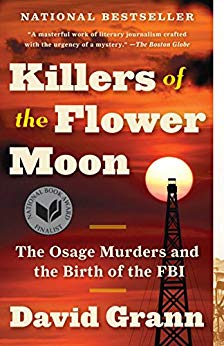

This article is an excerpt from the Shortform summary of "Killers of the Flower Moon" by David Grann. Shortform has the world's best summaries of books you should be reading.
Like this article? Sign up for a free trial here .
Who was Bryan Burkhart? What role did he play in the Osage murders?
Bryan Burkhart was the brother of Ernest Burkhart, a white man who was married to an Osage woman named Mollie. Ernest and other family members, including Bryan, plotted to kill Mollie’s family members (including Mollie herself) so that they could take control of her money.
Continue reading to learn about Bryan Burkhart and his involvement in the Osage murder conspiracy.
The Murder of Anna Brown
To understand the story of Bryan Burkhart, we must start on May 27, 1921. That day, the partially decomposed body of a 25-year-old Osage woman named Anna Brown was discovered in a ravine in Osage County, Oklahoma, dead from a bullet to the back of the head. Anna would be merely one of the first victims in a five-year-long Reign of Terror that would run from 1921 to 1926 and claim the lives of dozens (and possibly hundreds) of Osage men, women, and children.
Anna’s immediate family included her sisters, Mollie Burkhart and Rita Smith, and her mother, Elizabeth Kyle. Mollie was married to a white man named Ernest Burkhardt, a native of Texas who had moved to Osage County as a young man. Rita and Anna had also married white men.
Anna had been a vivacious, outgoing young woman. In the days before her disappearance, Anna’s family had been concerned about her behavior—she had been staying out late at night at speakeasies, often in the company of Bryan Burkhart, the brother of her sister Mollie’s husband. Anna had been missing for three days, immediately sparking her family’s worst fears. They were no strangers to loss—just a few years before, a younger sister named Minnie had died of a mysterious and unexplained wasting illness.
Bryan Burkhart: Prime Suspect
Mollie testified to the local justice of the peace that she had last seen Anna in the company of her brother-in-law, Bryan Burkhart. Bryan testified that he had dropped Anna off at home early in the evening, after which he’d gone back into town. The authorities even briefly detained both Bryan and Ernest Burkhart, though the evidence against them at this time was purely circumstantial and they were soon released.
By July 1925, Tom began to think Bryan Burkhart, brother of Ernest Burkhart (Mollie’s husband) and brother-in-law to Mollie and Rita, was the most likely perpetrator of Anna’s murder. He was the last person to have seen her alive when he dropped her off back home the evening she disappeared. Tom believed this, even though Bryan’s alibi was well-corroborated by people who claimed to have been in his company at the time of the killing, including his brother Ernest and his uncle, William Hale.
But Tom was undaunted, choosing to pursue a lead that had been buried by the original investigators. A group of men claimed to have seen Bryan driving a car with Anna later that evening in the nearby town of Ralston, after the time when he’d testified that he dropped her off at home. Several of these men came forward on the record that they had seen the pair, even though they recognized that they were putting themselves in mortal danger by doing so.
It appeared that Bryan had picked Anna up later, after taking her home, and that he had committed perjury in his original testimony. Pursuing the lead further, Tom spoke with multiple witnesses who now claimed to have seen Anna and Tom together at various times that evening, in the company of a mysterious “third man.” The pair were last seen at 3 a.m, during which Bryan brusquely ushered Anna out of a speakeasy and into his car. This new timeline shattered Bryan’s alibi.
Tom needed to identify who this unknown man was who had been with the couple the night Anna disappeared. Through his sources, he learned that Pike, the shadowy investigator originally engaged by William Hale back in 1921, claimed to know the identity of this third man. But Pike refused to come forward and was only located when he was arrested trying to commit a highway robbery.
Under interrogation, Pike revealed that he had not been hired by William Hale and Bryan Burkhart to help the original investigation—he had been hired to destroy it by manufacturing evidence and generating false leads. One of the tasks he undertook in his mission to subvert justice was to conceal Bryan’s true whereabouts on the night of Anna’s murder. He also added that Ernest Burkhart was sometimes present with his brother and uncle when these plans were discussed.
If what Pike was saying was true, then the supposedly benevolent William Hale was guilty of obstruction of justice in a murder case. The only question was whether Hale had been acting solely to protect his nephew Bryan from the law, or whether he had been involved in orchestrating Anna’s murder—and possibly dozens of others. It also implicated Ernest Burkhart. Was Ernest guilty of conspiring to kill his wife’s sister, and possibly poisoning Mollie herself? And if so, what was the motive?
Building the Case
In January 1926, U.S. Marshals arrested Ernest Burkhart. Hale, meanwhile, confidently and politely strolled into the county sheriff’s office to surrender. In conversations with reporters after being taken into custody, Hale was cordial and polite but refused to discuss anything about the case.
White knew that he needed to “break” Ernest and get him to turn on his uncle. Without a confession from Ernest, his case was weak—all he had was jailhouse testimony from Burt Lawson, who may well have been lying.
Ernest, finally, gave key information about the murder of Anna Brown. He said that the mysterious “third man” spotted with Anna and his brother, Bryan Burkhart, on the last night Anna was seen alive was Kelsie Morrison—a man who was later engaged by the Bureau to work as an undercover operative. Ernest said that Morrison was, in fact, the man who had put the bullet in Anna Brown. All the awful pieces of the puzzle were finally coming together.
He and Bryan Burkhart had gotten Anna drunk at a speakeasy before driving her out to Three Mile Creek. Bryan’s wife, Cole (who corroborated all the details of Morrison’s testimony) waited in the parked car to stand lookout. They then dragged the inebriated Anna down into the ravine. Bryan propped her up on a rock and held her still while Morrison shot her in the back of the head—with a gun that had been provided by Hale.
The trial to convict William Hale, Ernest Burkhart, Bryan Burkhart, and others was difficult and hindered by Hale’s political connections. Eventually, Bryan Burkhart was given immunity by the prosecution for providing evidence against Hale, and he never faced jail time for Anna Brown’s murder.

———End of Preview———
Like what you just read? Read the rest of the world's best summary of David Grann's "Killers of the Flower Moon" at Shortform .
Here's what you'll find in our full Killers of the Flower Moon summary :
- How the Osage tribe had vast oil wealth, but had it seized by their murderous neighbors
- The brutal and unresolved murders of Osage Native Americans
- The complicated history of the FBI in profiting from the Osage murders






